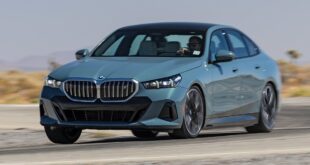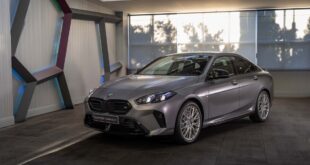 Munich. Can typical BMW driving pleasure also inspire in the compact segment? In the late summer of 2004, a sustainable and impressive answer to this question was provided. The BMW 1 Series made its debut – the first automobile to combine the brand’s characteristic driving dynamics, a sporty and elegant design and premium quality with the functional advantages of a five-door car with compact dimensions. 10 years further on, the BMW 1 Series is still the benchmark for sportiness in its class and the epitome of efficiency, reliability and innovative equipment features. Its unique qualities have rendered it a bestseller, with almost 1.9 million units having been sold worldwide.
Munich. Can typical BMW driving pleasure also inspire in the compact segment? In the late summer of 2004, a sustainable and impressive answer to this question was provided. The BMW 1 Series made its debut – the first automobile to combine the brand’s characteristic driving dynamics, a sporty and elegant design and premium quality with the functional advantages of a five-door car with compact dimensions. 10 years further on, the BMW 1 Series is still the benchmark for sportiness in its class and the epitome of efficiency, reliability and innovative equipment features. Its unique qualities have rendered it a bestseller, with almost 1.9 million units having been sold worldwide.
Meanwhile, the BMW 1 Series’ history is being continued with the second model generation, offering numerous highlights that reflect the series’ multifaceted potential and high level of appeal. The BMW 1 Series became the basis for a 5-door and a 3-door body variant, a coupe and a convertible, for the “World Green Car of the Year 2008â€, for the first BMW model with a CO2 emission level of less than 100 grams per kilometre, for the brand’s first electric vehicle for day-to-day use and for a BMW M automobile with 250 kW/340 hp, for the leader of the endurance test ranking of the trade magazine “Auto Bild†and the winner of the “Goldenes Lenkrad†in 2008 and 2011.
Thanks to the implementation of extensive EfficientDynamics technology, the BMW 1 Series became the leading pioneer in the consistent reduction of fuel consumption and emission levels. It was the brand’s first series to include as from 2007 an Auto Start Stop function, a gearshift indicator, brake energy regeneration and electric power steering and more. Thanks to its enormous popularity, the BMW 1 Series also became the driving force for the steadily increasing sales figures achieved by the world’s most successful premium automobile manufacturer.
Unique in the compact segment: A typical BMW for the “Joy Principleâ€.
With the Munich-based premium carmaker’s venture into the compact segment, the unmistakable characteristics of a BMW model were adopted into a new format. The brand-typical proportions with a long bonnet, short overhangs, a long wheelbase and an aft-set passenger cell, the temperamental and dynamically designed body surfaces, the driver-oriented cockpit arrangement, powerful, longitudinally installed engines, high-class suspension technology and power transmission to the rear wheels, to this very day still unique in its class, all helped the BMW 1 Series attain its outstanding position that became the starting point for its worldwide sales success. From the very beginning, the BMW 1 Series underscored its significance through sophisticated, innovative equipment options previously only available in higher vehicle segments. Runflat tyres, adaptive headlight range control, a two-stage brake light, the Start/Stop unit and options such as Comfort Access, the iDrive control system as well as driver assistant systems and mobility services from BMW ConnectedDrive using intelligent networking found their way into the compact class with the BMW 1 Series. Moreover, the BMW 1 Series also took on an exemplary role in terms of safety. In the Euro NCAP crash test, both the first (2004) and the second model generation (2011) each received the highest rating of 5 stars.
In order to highlight the new model’s exceptional qualities and reach additional target groups, new approaches were also adopted in the field of PR and marketing. For the first time and in addition to conventional advertising, a comprehensive online campaign and communication methods conceived exclusively for use with smartphones played a crucial role. On the website www.Prinzip-Freude.de, test drives were propagated at an early stage. Star of the TV spot released under the motto “Joy†was none other than Kermit the frog. With his unconventional, self-mocking charm, the world-famous protagonist of the Muppet Show proved to be the ideal figure to promote the new model.
Compact driving pleasure in great variety: BMW 1 Series in four body variants.
The BMW 1 Series was originally launched as a classic four-door hatchback with a large tailgate. Within the framework of the model update in the spring of 2007, the 5-door car was supplemented by a sport-oriented 3-door body variant, which clearly asserted the dynamic driving characteristics of the BMW 1 Series, of which more than 200,000 had been sold by that time. Additional dynamics came into play with the introduction of the third model in November of the same year. As a two-door model featuring a classic three-box design, four seats and exceptionally powerful engines, the BMW 1 Series Coupe offered the most intensive form of driving pleasure in the compact segment, with sales of more than 150,000 units worldwide before being replaced last year. The BMW 1 Series Convertible with a classic soft top and a low shoulder line guaranteeing that brand-typical open driving experience, was equally as successful. The first open-top premium automobile in the compact segment followed in April 2008, finally selling more than 130 000 times.
The current model generation of the BMW 1 Series (fuel consumption combined: 8.0–3.8 l/100 km; CO2 emissions combined: 188–99 g/km) is available both in a 5-door and a 3-door version. Furthermore, BMW emphasises the increased significance of premium compact models for the international automotive markets by supplementing the product range with a second series. With the introduction of the BMW 2 Series Coupe (fuel consumption combined: 8.1–4.3 l/100 km; CO2 emissions combined: 189–114 g/km) and the BMW 2 Series Convertible (fuel consumption combined: 8.5–4.4 l/100 km; CO2 emissions combined: 199–116 g/km), driving dynamics and sporty elegance have reached a new dimension within the compact segment.
Further information on official fuel consumption figures, specific CO2 emission values and the electric power consumption of new passenger cars are included in the following guideline: “Leitfaden über Kraftstoffverbrauch, die CO2-Emissionen und den Stromverbrauch neuer Personenkraftwagen” (Guideline for fuel consumption, CO2 emissions and electric power consumption of new passenger cars), which can be obtained from all dealerships, from the Deutsche Automobil Treuhand GmbH (DAT), Hellmuth-Hirth-Str. 1, 73760 Ostfildern-Scharnhausen and at http://www.dat.de/angebote/verlagsprodukte/leitfaden-kraftstoffverbrauch.html. LeitfadenCO2 (Guideline CO2) (PDF ‒ 2.7 MB)
 BMW.SG | BMW Singapore Owners Community The Ultimate BMW Community – Established Since 2001
BMW.SG | BMW Singapore Owners Community The Ultimate BMW Community – Established Since 2001













